Misunderstandings are a frequent occurrence in the workplace. Whether you’re speaking to your coworkers in person or communicating in writing, your words are always going to be subject to interpretation.
But, what if there was a way to avoid miscommunication and increase team productivity, while you’re at it?
According to recent reports, both business leaders and knowledge workers agree that effective communication increases productivity, confidence, and even job satisfaction.
So, is there a way to learn how to become an effective communicator? Well, to begin with, you should focus on honing effective communication skills such as:
- Clarity of expression,
- Empathy and emotional intelligence,
- Active listening, and
- Giving and receiving feedback.
Going forward, we’ll discuss the importance of these core communication skills and share some expert tips to help you develop them.

- The 4 key effective communicator skills that can improve your professional communication include clarity, emotional intelligence, active listening, and the ability to give and receive feedback.
- Developing these communication skills can help you avoid miscommunication, resolve conflicts, and increase your influence.
- Having even one effective communicator on your team has the power to transform the rest of its members into effective communicators, too.
- You can practice your effective communication skills in person or by exploring all the features available in your team communication software.
Core skill #1: Clarity
Being able to express your thoughts and ideas clearly and concisely is sure to help you avoid miscommunication in the workplace.
After all, as Svetlana Kouznetsova, a B2B accessibility consultant, public speaker, and author, told us, the best way to fight ambiguity in communication is to use simple language everyone can understand:

“Effective communicators consistently keep messages:
- Simple,
- Structured, and
- Free of ambiguity.
Know your key takeaway and check in to ensure it’s understood.”
But, if you want to increase the clarity of your spoken or written communication, you’ll first need to understand what you’re looking to gain from any conversation, whether you want to:
- Influence or persuade higher-ups or clients to accept your ideas,
- Communicate expectations to a subordinate, or
- Resolve a conflict in your team.
Once you know exactly what you’re hoping to achieve and who your audience is, you’ll be able to adjust your communication style and phrasing accordingly.
Having said that, let’s talk about some practical tips for communicating more clearly and concisely in the workplace.
How to achieve total clarity and fight ambiguity in professional communication
If you want the people you work with to understand what you’re saying, start by scrubbing your vocabulary of corporate buzzwords and industry jargon.
Instead, focus on communicating your main point in simple terms. While you’re at it, you should also make it scannable, as Ted Skinner, author and the VP of Marketing at a media monitoring company, suggests:

“The best communicators I’ve worked with share 3 core abilities. They:
- Match the message to the medium. Too many professionals default to whatever platform they opened last, and that’s how critical information gets buried.
- Write for scanning, not reading. Strong communicators front-load the main point, use strategic formatting sparingly, and respect the reality that attention is limited.
- Pause before sending. They consider how their words will land with someone who can’t see their face or hear their tone.”
In practice, Skinner’s advice can look like:
- Using a team communication app instead of email,
- Formatting your messages to make them more scannable, and
- Taking a moment to reread your draft before sending it, as seen in the image below.
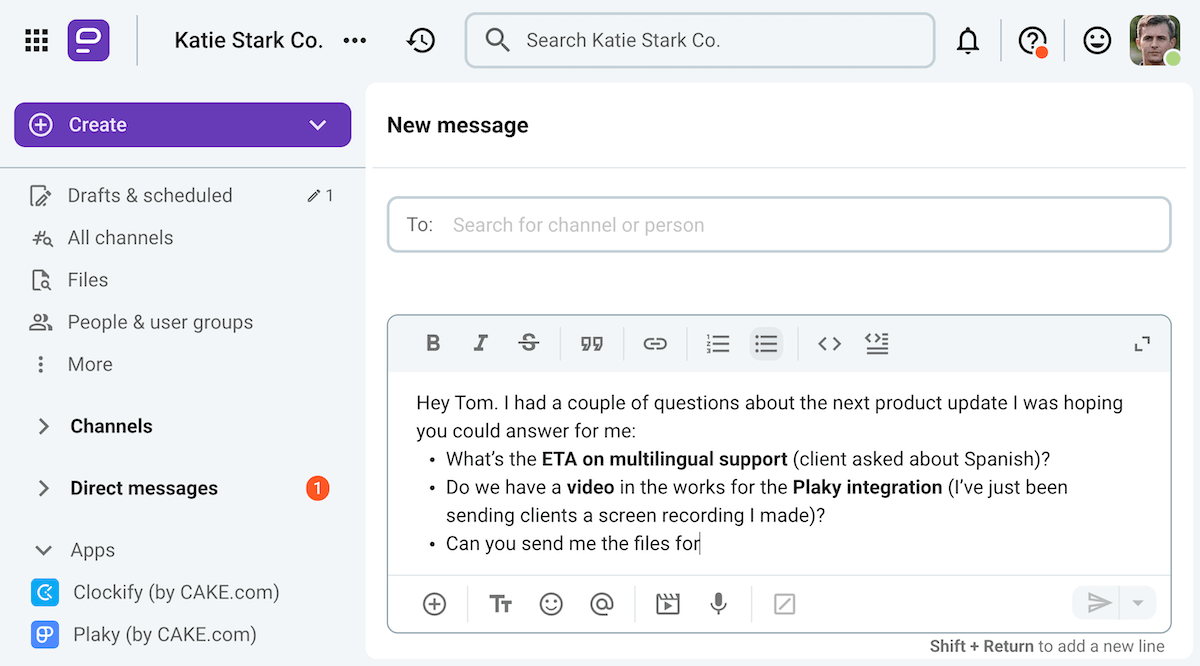
As an accessibility consultant, Kouznetsova also recommends using different communication channels:

“Communication is not just speaking and listening. Text, visuals, captions, gestures, and signing are equally valid. When one method doesn’t work, effective communicators switch without frustration.
So, offer multiple ways to communicate— voice, text, email, captions, visuals, signing, quieter spaces, better lighting. One size never fits all.”
Using a team communication app like Pumble by CAKE.com allows you to take full advantage of these various communication channels by letting you:
- Share files and images to illustrate your points,
- Get on a voice or video call to enjoy real-time communication, or
- Send video messages and share your screen, as shown below.
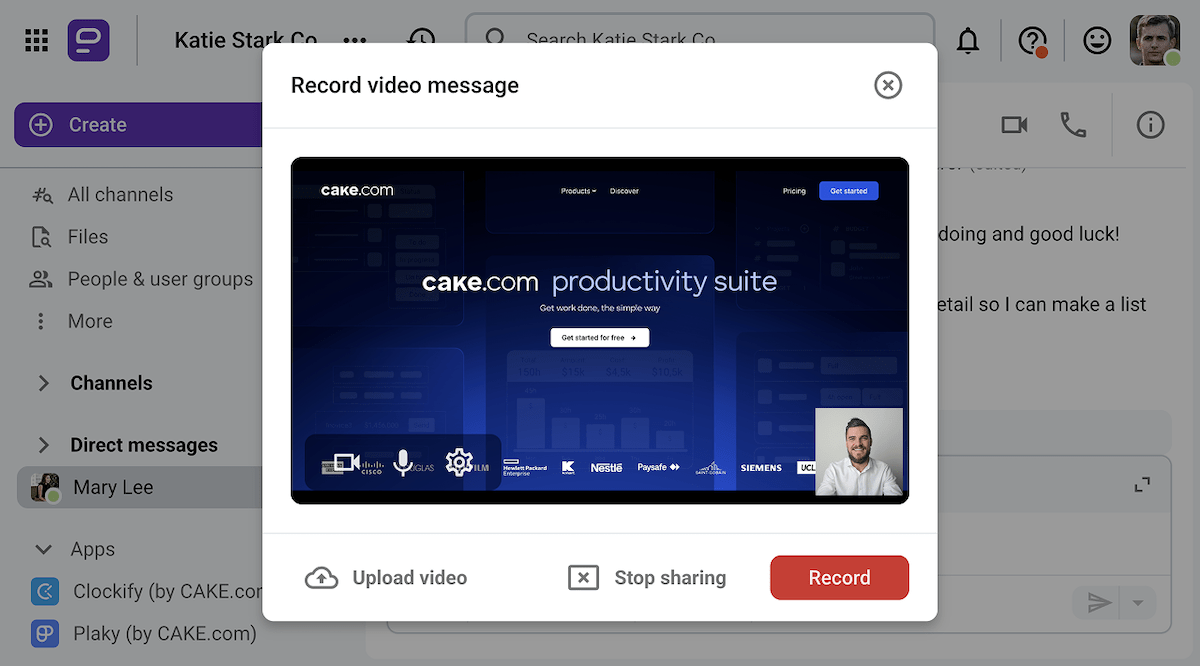
Core skill #2: Empathy & emotional intelligence
Without empathy, professional communication can become somewhat cold and impersonal.
Though impersonal communication can still be clear and concise, making people respond to your message is difficult when it’s not delivered in an empathetic manner.
With that in mind, we might say that emotional intelligence is one of the most important skills of effective communicators — at least according to experts like Linda Pophal, SHRM-SCP, SPHR, a strategic marketing communication consultant and content marketer:

“Communicators can benefit from developing and improving their emotional intelligence— a concept that was popularized by Daniel Goleman and includes characteristics such as:
- Self-awareness,
- Self-management,
- Social awareness, and
- Relationship management.”
Of course, empathy is also a crucial component of effective communication, as Pophal notes:

“Empathy is also critical — putting yourself in the other’s shoes to truly understand their perspective, background, needs, interests, etc. What’s important to them in this instance/situation? Why is it important? What do they fear? What do they hope for?”
Being able to understand others is certainly a professional advantage.
However, it’s also a great way to build rapport with your coworkers and, in doing so, create psychological safety and lay the foundations of a positive work environment where everyone is encouraged to express themselves more freely.
How to communicate with empathy and emotional intelligence at work
At the end of the day, practicing empathic communication is all about approaching others with curiosity instead of judgment.
In other words, you should do your best to understand where other people are coming from instead of projecting your own preconceived beliefs and subconscious biases on them.
If you’re unsure what someone is feeling, you can always ask, as seen in the example below.
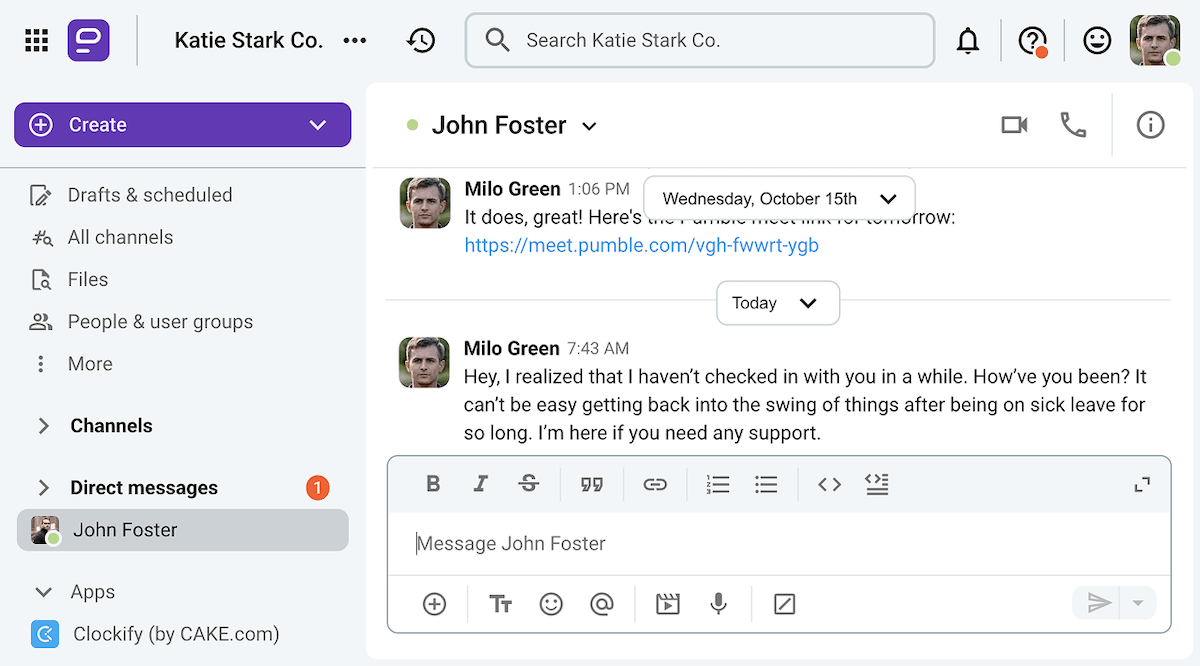
Then again, if you don’t want to be that overt, you can always focus on the other person’s nonverbal behaviors and body language, especially during virtual meetings.
Either way, you should try to stay respectful — even when you disagree with someone or fail to understand their point of view. If that doesn’t come naturally to you, consider investing in some type of soft skills training.
As a deaf person herself, Svetlana Kouznetsova is a passionate proponent of deaf awareness and accessibility training:

“Inclusive communication is a skill. I provide deaf awareness and accessibility training that helps teams communicate effectively with deaf and hard of hearing people — and improves communication for everyone.”
You could also participate in cultural sensitivity training to better understand how people from different cultural backgrounds interpret messages, as Chelsea Dade, the founder of a youth workforce development hub and consultancy, suggests:

“Cultural competence is the awareness of how one’s own identity, lived experience, and power dynamics shape their communication style. Engaging in cross-cultural learning (workshops, readings, conversations) can help us better understand how people interpret messages differently.”

🎓 PUMBLE PRO TIP
Interested in learning more about diversity in communication? Check out these guides:
Core skill #3: Active listening
Ultimately, a good communicator shouldn’t only know how to express their own thoughts and ideas. Rather, those looking to improve their communication skills should also spend some time honing their listening skills.
We spoke to Christine Samuel, a speaker, author, and the founder of a company that offers leadership and team coaching and facilitation services. She told us that effective communication is all about achieving mutual understanding:

“Effective communication isn’t really about information exchange. It’s about building relationships where real understanding can happen and where people can actually collaborate.”
To increase our chances of understanding our interlocutors’ true feelings and objectives, we must be prepared to engage in active listening. That requires both empathy and emotional intelligence, as these effective communication skills tend to enhance our self-awareness as well as social perception.
Generally speaking, active listening requires us to:
- Eliminate potential distractions that may hinder our attempts to focus,
- Be patient with our interlocutors and try to suppress any preconceived notions, and
- Offer appropriate responses, whether they’re nonverbal acknowledgements, relevant feedback, or otherwise.
Having said that, let’s see some tips for becoming a better listener.
How to master active listening to hear the unsaid
Ultimately, active listening is all about becoming more open to other people’s perspectives and making sure they feel heard.
So, instead of listening passively while you wait for your turn to speak, try engaging in deep listening, as Christine Samuel suggests:

“The principle is simple. Listen to understand. When you actually grasp what someone is thinking and what they need, you can respond in ways that connect. Your words land because they speak to what’s real for them.
But here’s what people miss. You also need to listen to yourself during conversations. When you’re aware of your own emotions and needs in the moment, you can express yourself clearly and connect authentically.”

In the interest of reaching a true understanding, take a moment to create an environment that allows you to focus on what your interlocutors are saying.
To do that, you should eliminate any communication barriers that might hinder your efforts, as Svetlana Kouznetsova recommends:

“Noise, lighting, and visual distractions affect comprehension. Effective communicators notice and adjust. Reduce environmental barriers — face the person, minimize noise, and use good lighting.”
Even when you’re not speaking, you can still show your interest in what your interlocutors are saying by:
- Maintaining eye contact and having a relaxed and open posture,
- Keeping interruptions to a minimum (though you can still politely interject at certain points during the conversation),
- Confirming your understanding by paraphrasing statements and asking clarifying questions.
Though many people avoid inconveniencing their interlocutors by asking for repetition or clarification, effective communicators should always prioritize understanding, as Kouznetsova reminded us:

“Bluffing is common among both hearing people and people with hearing disabilities because asking for repetition feels ‘inconvenient.’ Good communicators eliminate the stigma by checking in and making understanding a shared responsibility.”
Core skill #4: Giving & receiving feedback
If you want to learn how to become an effective communicator, chances are that you’re pretty open to receiving feedback.
According to Linda Pophal, that openness to feedback and willingness to practice your communication skills are some of the most important traits of effective communicators:

“Working on these skills takes practice, humility, and openness to feedback. Effective communicators have honed their skills over the years by being self-critical as well as by seeking feedback proactively from others.”
Of course, asking for feedback and being able to provide it are two different skills — though they do share some features.
After all, both of these activities require a certain amount of impartiality and detachment, while also incorporating elements of the other skills we’ve discussed, namely:
- Clarity, or the ability to express your feedback concisely and without ambiguity,
- Empathy and emotional intelligence, or the ability to consider the emotions of the other person when sharing constructive feedback, and
- Active listening, or the ability to focus on the underlying intent of the speaker (for example, when receiving feedback, understanding that the other person is trying to help you improve your skills, not crush your spirit).
With that in mind, let’s talk about how effective communicators go about giving and receiving feedback.
How to build trust by giving and receiving feedback
When leaders lack clarity and emotional intelligence, employees can start to fear feedback instead of inviting it, which can hinder their professional development. After all, poor communicators tend to:
- Vaguely hint that something was done badly without pointing out the specifics,
- Raise their voice while sharing feedback with subordinates, and, worse still,
- Share negative feedback in front of others, thereby making the recipient feel singled out.
So, how do you assertively communicate your opinions without negatively affecting employee morale?
Well, you could try doing the opposite of what we just shared by making sure your feedback is specific and actionable and delivering it in private so the recipient doesn’t feel called out.
Of course, if you want to point out a frequent mistake to the rest of your team, you can still do so without singling out the person who inspired the announcement.
Conversely, if you want to share positive feedback or praise someone, it’s best to do it publicly, so the rest of the team can join in recognizing their colleague’s achievements.
On the other hand, you should also work on the skill of receiving feedback gracefully. Instead of getting defensive, simply thank the other person for sharing their thoughts and make a note to follow through on their feedback.
Here’s what giving and receiving feedback might look like in a team communication app like Pumble.
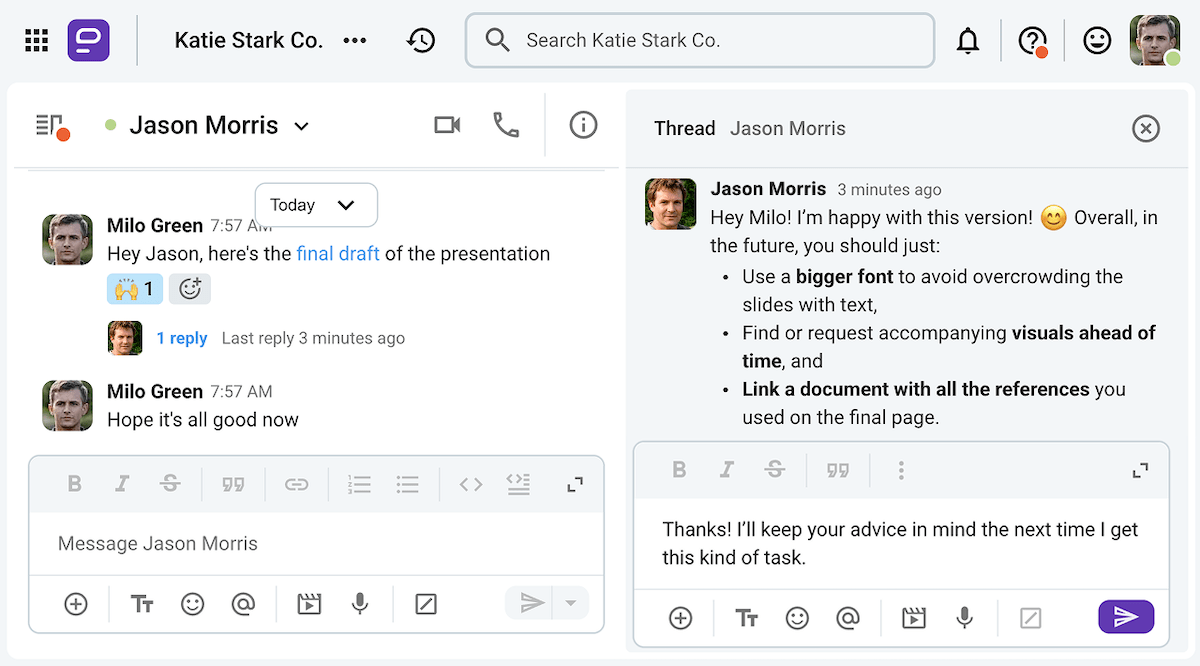
Create the right environment for effective communication with Pumble
Having even one effective communicator on your team has the power to transform the rest of its members into effective communicators, too.
However, this process takes time and can be somewhat frustrating for employees who take it upon themselves to encourage their coworkers to practice effective communication with them.
So, what can managers do to encourage that positive transformation?
Well, as with any other skill, if you want to help your employees become effective communicators, you need to give them an opportunity to practice their communication skills.
The team communication app, Pumble, can easily become your employees’ practice ground, allowing them to:
- Exercise clarity by taking the time to draft their messages and format them for scannability,
- Develop empathy and emotional intelligence by participating in virtual workshops through Pumble,
- Engage in active listening by paying attention to their coworkers’ nonverbal communication during video calls,
- Share specific and actionable feedback in threads under messages, and even
- Stay accountable by saving feedback messages, as shown in the image below.
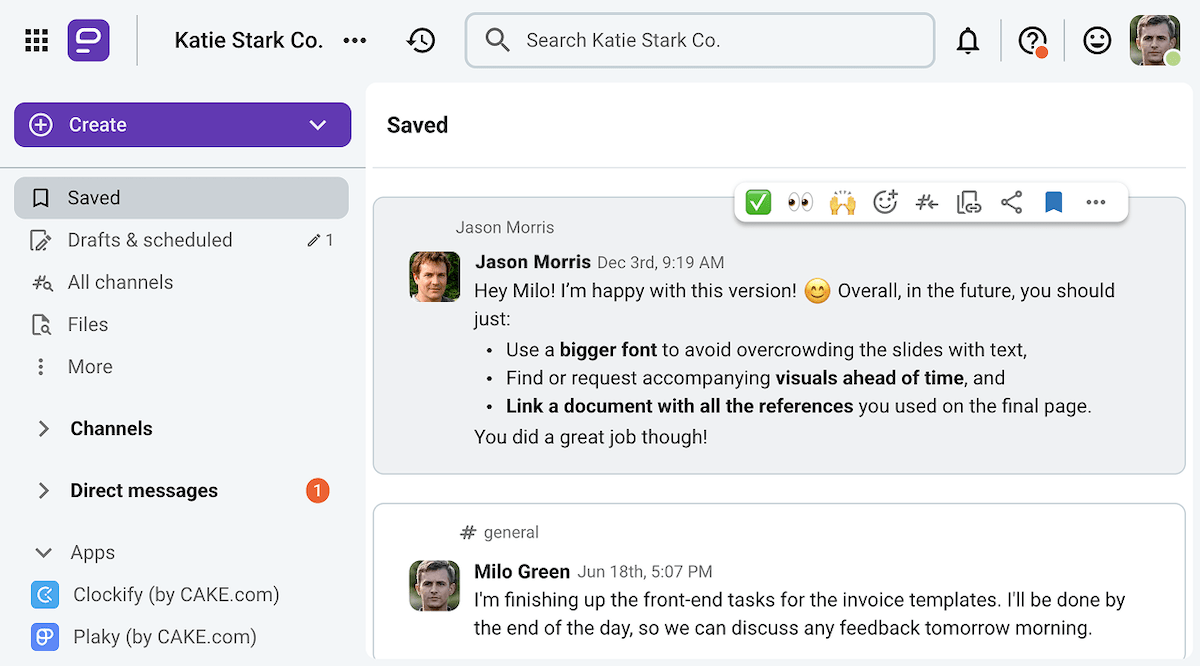
What makes a good communicator?
Lots of practice — with the right tools.
How we reviewed this post: Our writers & editors monitor the posts and update them when new information becomes available, to keep them fresh and relevant.


